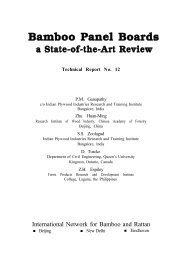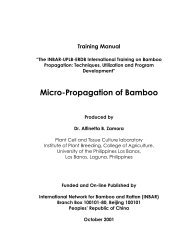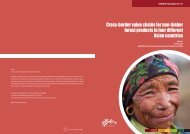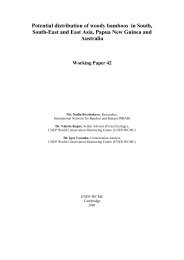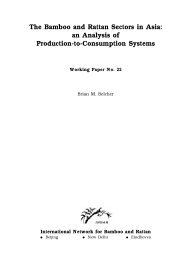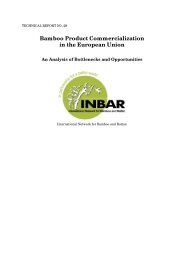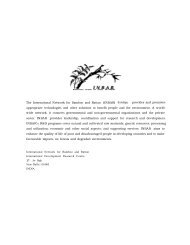ISSN ………… - International Network for Bamboo and Rattan
ISSN ………… - International Network for Bamboo and Rattan
ISSN ………… - International Network for Bamboo and Rattan
Create successful ePaper yourself
Turn your PDF publications into a flip-book with our unique Google optimized e-Paper software.
7. FIBRE MORPHOLOGY<br />
Fibre length of bamboo is generally greater than that of hardwoods. The fibre morphology of 12<br />
bamboo species from India showed a mean fibre length ranging from 1.01 to 4.03 mm (Bhargava<br />
1945) 136 . Various studies have been reported on the fibre dimensions of different bamboo species<br />
from different countries <strong>and</strong> their suitability <strong>for</strong> commercial pulping [Seabra (1954) 189 on some<br />
African bamboos; Istas et al. (1956) 159 ten species from Belgian Congo; Du (1957) 386 on seven<br />
Taiwan species including Sinocalamus latiflorus having the longest fibre; Ku (1971) 165 on the<br />
Thail<strong>and</strong> species Bambusa beecheyana Munro var. pubescens; <strong>and</strong> on the Indian species Bambusa<br />
vulgaris, Dendrocalamus strictus, Oxytenanthera monostigma <strong>and</strong> Melocanna baccifera by<br />
Maheshwari et al. (1976a) 227 , Azzini (1976) 366 <strong>and</strong> Guha et al. (1980) 457 ]. Varshney (1965) 262<br />
reported the effect of anatomical characteristics of bamboos on pulping. The quality of the cook,<br />
especially the mechanical properties of the pulp are determined by the degree of impregnation of<br />
cooking chemicals in the chips, the diffusion rate during cooking <strong>and</strong> the amount of screen rejects <strong>and</strong><br />
by the residual parenchyma <strong>and</strong> ray cells. Pulps made from different species of bamboo show less<br />
variation than expected (Grant 1962) 37 . The fibre content was found to increase with culm height <strong>and</strong><br />
decrease from outer to inner part of the culms in Phyllostachys reticulata of age 1-6 years (Kitamura<br />
1962) 332 . But, the variation in parenchyma proportion in this species due to age was not significant.<br />
The parenchyma proportion in Phyllostachys reticulata was very close to that of Dendrocalamus<br />
strictus Singh et al. (1971) 354 . In general, it is there<strong>for</strong>e probable that parenchyma proportion in<br />
different species varies within narrow limits only; fibre dimensions, however, vary widely in different<br />
species (Monsalud 1965) 338 .<br />
Chu <strong>and</strong> Yao (1964) 326 provided details on the fibre length, cell wall thickness <strong>and</strong> percentage of<br />
fibres <strong>and</strong> other elements of 33 Chinese bamboo species <strong>and</strong> classified these bamboos on the basis of<br />
fibre characteristics <strong>for</strong> pulp <strong>and</strong> paper. Out of these, 21 species were found promising <strong>for</strong> yielding<br />
high quality pulp. Later, Xia (1989) 241 reported the fibre length of eight Chinese bamboo species.<br />
The fibre dimensions, flexibility coefficients, Runkel <strong>and</strong> slenderness ratios of four Thai bamboo<br />
species were described by Premrasmi <strong>and</strong> Aranyaputi (1965) 63 . Monsalud (1965) 338 described the<br />
fibre characteristics of 13 Philippine bamboo species. Unlike woods, fibre dimensions or their derived<br />
values are not useful in classifying bamboos. The fibre dimensions of some Philippine bamboos <strong>for</strong><br />
long fibred paper pulps were described by Tamolang (1962) 355 , Monsalud <strong>and</strong> Tamolang (1962) 8<br />
<strong>and</strong> Zamuco (1972) 359 . The morphological as well as chemical composition <strong>and</strong> suitability <strong>for</strong><br />
pulping of various bamboo species as well as pulping processes were reviewed by Ukil (1961) 203 <strong>and</strong><br />
Witkoski (1964) 210 .<br />
43



